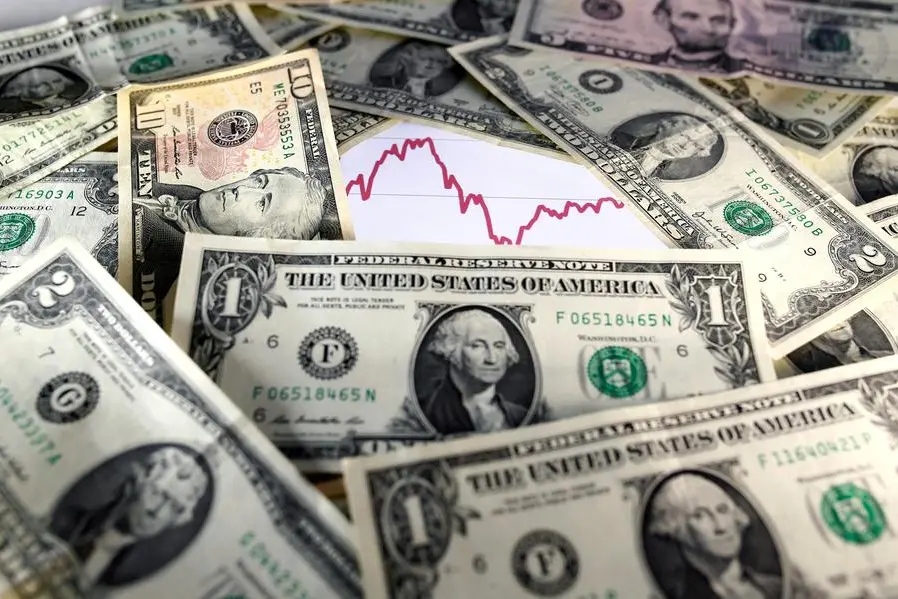PHOTO
FILE PHOTO: U.S. dollar notes are seen in front of a stock graph in this November 7, 2016 picture illustration. Picture taken November 7. REUTERS/Dado Ruvic/Illustration/File Photo
BUDAPEST/PRAGUE - With steep falls in inflation over and the timing of the first Federal Reserve rate cut pushed back by strong U.S. data, a period of carefree rate easing appears to be over for central Europe's rate-setters now facing a growing list of concerns.
A collapse in price growth from last year's double-digit rates in Poland, the Czech Republic and Hungary allowed central banks to reduce borrowing costs sharply, helping their economies back to growth from recession or stagflation.
March headline inflation sank to 2% in Poland and the Czech Republic and 3.6% in Hungary, which experienced the worst inflationary surge in the European Union with levels exceeding 25% in the first quarter of last year.
But economists believe the current lows are unsustainable and project a rebound in price growth to around 5% by the end of 2024 in both Poland and Hungary, as helpful base effects fade and the Polish government unwinds cost-of-living subsidies.
Amid risks from higher fuel prices, weaker exchange rates, persistently strong services inflation and the prospect of the region's economic recovery gaining traction, central bankers have grown cautious about cutting rates further.
"The situation has changed," economists at Allianz said. "As markets have dialled back their expectations for cuts in advanced economies, they have also done the same for emerging markets."
An analysis of changes in market pricing based on JP Morgan figures shows investors have priced out about 100 basis points of rate cuts in the Czech Republic and Poland by December compared with end-2024 levels expected in early January.
The shift is the largest in Hungary, with investors slashing the scope of expected easing by nearly 200 bps. Late-April market pricing showed just 35 bps of cuts in Poland's main rate by the end of 2024, less than a third of what was priced in at the start of the year.
VULNERABLE CURRENCIES
While 2024 inflation is seen hovering around 2% in the Czech Republic, by far the lowest in central Europe, some rate-setters there too have expressed concerns over real wage growth and currency weakness as the economy begins to show signs of life.
The region's currencies, like other emerging market assets, were hammered by data showing the strength of the U.S. economy, which boosted the dollar and pushed back investor bets on the timing of the first Federal Reserve rate cut to September - or later.
The Czech crown and the Hungarian forint are both in the red for 2024, due in part to their narrowing rate differential, with the ripple effects of the dollar's rally knocking even Poland's zloty off the four-year-highs it scaled early this month.
"CZK and PLN are among the most vulnerable emerging market currencies to persisting inflation, U.S. economic outperformance, and higher repricing of the Fed funds rate path," strategists at Societe Generale said, citing the currencies' strong ties with the euro.
Last week Czech National Bank Governor Ales Michl said even if the bank cuts rates on Thursday, with analysts projecting another 50 bps reduction, the CNB would take a "very cautious" approach to rate easing beyond that point.
"The more cautious approach of monetary institutions to rate cuts in view of possible reflation is evident on both sides of the Atlantic," ING economists said. "After all, the European Central Bank is watching the Federal Reserve, and the CNB is watching the ECB."
Hungary's central bank has also flagged a cautious approach to further easing, with Deputy Governor Barnabas Virag all but ruling out rate cuts in the second half after the bank lowered its base rate by just 50 bps last week, the smallest step in an easing cycle launched last May.
Another 50-bps Czech rate cut in June, which economists think is on the cards, would take the Czech rate within a whisker of the European Central Bank's main rate by June, when the ECB is widely expected to start cutting rates. How fast the ECB cuts rates after that is less certain, with markets having scaled back bets on euro zone rate cuts in the second half of the year.
"While we continue to expect the (Czech) policy rate to reach 3.50% by the end of the year, we see risks to our call as being skewed to the upside," Morgan Stanley economist Georgi Deyanov said, citing currency weakness and possible shifts in ECB rate expectations as factors in coming months.
(Additional reporting by Marc Jones in LONDON Writing by Gergely Szakacs Editing by Christina Fincher)





















